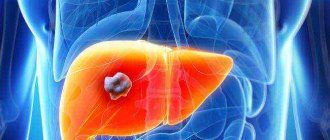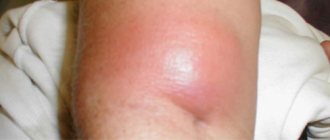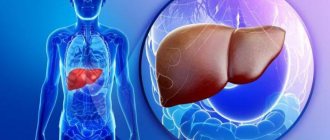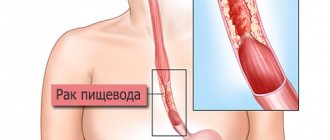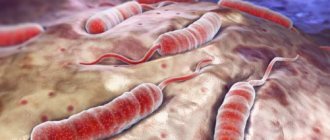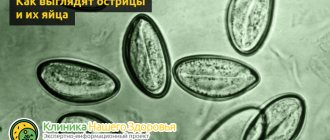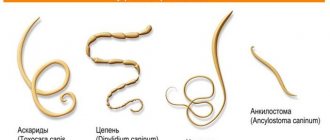What is a liver abscess
Liver abscess is an inflammatory disease in which a cavity filled with pus is formed in the parenchyma of the organ.
The causes of liver abscess can be different, but most often the provoking factor is the activity of pathogenic microorganisms, bacteria or helminths.
- Diagnosis is carried out based on the results of ultrasound, MRI, CT.
- The initial stage of the pathology is treated with medications (antibiotic therapy); if the case is particularly complex and advanced, an operation is performed to open the abscess.
- Laparoscopic interventions for such pathologies are used quite rarely; pus is removed using a special needle.
You can read more about liver abscess in this article.
Operational
Surgical therapy for liver abscess is often prescribed. In this case, a laparoscopic method is used, which involves introducing thin needle instruments into the organ, draining the pathological neoplasm and creating a path for the purulent exudate to exit.
After surgery, antibacterial drugs are prescribed to reduce the risk of complications.
Causes of liver abscess
The main role in the occurrence of purulent liver abscess is played by pathogenic microflora. There are many ways for bacteria to enter the gland. Most often, liver abscess develops against the background of:
- cholangitis - inflammation of the bile ducts;
- cholecystitis - inflammation of the gallbladder;
- gallstones;
- appendix rupture;
- perforation of the stomach walls, caused by peptic ulcer;
- any diseases of the sepsis type;
- organ cysts.
Microorganisms, once in the liver parenchyma, begin to multiply rapidly. This causes purulent melting of the gland tissue and the formation of a purulent mass. Changes begin to occur in the structure of the organ, ending with the formation of a small cavity with a capsule of dense fibrous tissue.
Pus accumulates inside the capsule. This is how the body fights the melting of the liver parenchyma and stops the inflammatory process.
Helminths can also cause liver abscess . For example, echinococci, roundworms, dysenteric amoebas. The latter provoke amoebic liver abscess (extraintestinal dysenteric amebiasis).
The disease is contagious and is transmitted by the fecal-oral route. Eggs laid by parasites on fruits and vegetables, if basic hygiene rules are not observed, easily enter the human body: first into the intestines, and then, through the bloodstream, into the liver, where their rapid development begins.
After a certain period of time, there are so many worms that they clog the small liver vessels, and access to the organ tissues is closed to oxygen and nutrients. Necrotic processes occur in the liver, which leads to purulent degeneration.
Another reason for the development of an abscess is fungal flora . People with significantly weakened immune systems, those who have undergone chemotherapy courses, and those with leukemia are at risk here. Due to pathogenic fungi, the disease occurs quite rarely, but nevertheless such cases have been recorded by medical statistics.
Video
We offer you to watch a video on the topic of the article.
Education: Rostov State Medical University, specialty “General Medicine”.
Found an error in the text? Select it and press Ctrl + Enter.
The rarest disease is Kuru disease. Only members of the For tribe in New Guinea suffer from it. The patient dies of laughter. The disease is believed to be caused by eating human brains.
According to WHO research, talking on a mobile phone for half an hour every day increases the likelihood of developing a brain tumor by 40%.
In an effort to get the patient out, doctors often go too far. For example, a certain Charles Jensen in the period from 1954 to 1994. survived more than 900 operations to remove tumors.
The liver is the heaviest organ in our body. Its average weight is 1.5 kg.
Tooth decay is the most common infectious disease in the world, which even the flu cannot compete with.
Human bones are four times stronger than concrete.
Even if a person's heart does not beat, he can still live for a long period of time, as the Norwegian fisherman Jan Revsdal demonstrated to us. His “engine” stopped for 4 hours after a fisherman got lost and fell asleep in the snow.
According to many scientists, vitamin complexes are practically useless for humans.
Dentists appeared relatively recently. Back in the 19th century, pulling out diseased teeth was the responsibility of an ordinary hairdresser.
Scientists from Oxford University conducted a series of studies in which they came to the conclusion that vegetarianism can be harmful to the human brain, as it leads to a decrease in its mass. Therefore, scientists recommend not completely excluding fish and meat from your diet.
The highest body temperature was recorded in Willie Jones (USA), who was admitted to the hospital with a temperature of 46.5°C.
Regular use of a solarium increases your chance of developing skin cancer by 60%.
When we sneeze, our body stops working completely. Even the heart stops.
A job that a person doesn’t like is much more harmful to his psyche than no job at all.
A person taking antidepressants will, in most cases, become depressed again. If a person has coped with depression on his own, he has every chance to forget about this condition forever.
Treatment in Israel is an integrated approach to diagnosing the disease, drawing up individual therapeutic regimens, rehabilitation and assistance in social adaptation.
Liver abscess
- This is a limited cavity located in the liver and filled with pus. Develops as a result of other diseases or primary lesions. It manifests itself as pain in the right hypochondrium, fever, and yellowness of the skin. The diagnosis is made by collecting anamnesis, examination, ultrasound of the liver, and the use of auxiliary research methods. Treatment can be conservative (antibiotic therapy) or surgical (opening an abscess). The prognosis of the disease with timely initiation of treatment is favorable.
Classification
There are many classifications of liver abscesses. So, depending on the route of penetration of the pathogen, an abscess occurs:
- hematogenous (with blood flow through the hepatic artery or portal vein);
- cholangiogenic (through the bile ducts);
- contact (against the background of inflammation of the gallbladder and bile ducts);
- traumatic (when receiving an open or closed injury to the abdominal cavity).
Depending on the location in which the process occurs, an abscess can be:
- right-sided (occurs in 2 out of 3 diagnosed cases);
- left-handed.
Depending on the presence or absence of concomitant pathologies, an abscess can be:
- primary, arising in healthy liver parenchyma;
- secondary, developed as a complication of any disease.
Depending on the number of abscesses, an abscess can be:
- single;
- multiple.
According to statistics, liver abscess is more often diagnosed in men than in women. The risk group also includes elderly people (after 70 years), patients suffering from cirrhosis of the liver, diabetes mellitus, pathologies of the immune system of any pathogenesis, and pancreatic diseases.
Symptoms of the disease
A liver abscess does not have characteristic symptoms unique to it. Very often the disease proceeds in the same way as other pathologies of the liver and biliary tract. Most often in patients:
- your health worsens, weakness and malaise appear;
- body temperature rises, which confirms the presence of inflammatory processes in the body;
- pain appears in the area of the right hypochondrium, increasing with palpation;
- the liver increases in size and begins to protrude beyond the edges of the costal arch;
- the mucous membranes acquire a yellow tint, the skin acquires an earthy tint.
Second phase
- Sharp and severe pain localized in the hypochondrium on the right side.
- Enlargement of the liver, which is felt upon palpation.
- Enlarged spleen.
- Ascites.
- Hemorrhoids.
- Jaundice. Occurs when there is a large amount of suppuration on the surface of the liver.
- Weight loss.
- Dark urine, possible blood clots in stool.
Liver abscess manifests itself with pronounced symptoms, but at the initial stage of development of the pathology, patients often mistake the signs for poisoning and do not turn to a specialist. The main feature is that the pathology is difficult to establish immediately after its development, so it is impossible to identify signs against the background of the underlying disease. It is for these reasons that treatment can be difficult, since patients turn to a doctor when the disease becomes a threat to the patient’s life.
Possible complications of the disease
If the abscess is not treated, it will begin to progress. In this case, it will not be possible to avoid serious complications. If the pathology is neglected, it can be fatal, since the pus, constantly increasing in volume, spreads to healthy tissues, and the liver gradually loses its functions.
The most dangerous complication of liver abscess is considered to be subphrenic abscess . It occurs due to the fact that the liver tissue ruptures and pus pours into the cavity located under the dome of the diaphragm.
Pus may also end up in the pleural or peritoneal cavity, resulting in infection of the serous membranes, the development of peritonitis and sepsis (blood poisoning).
When pus penetrates into the pericardial sacs, there is a risk of developing pericarditis (inflammation of the outer lining of the heart). In addition, lung tissue can become infected and fistulas can form.
An increase in pressure in the hepatic collar vein system threatens the development of internal bleeding or ascites (fluid accumulation in the abdominal cavity). The most dangerous thing is the fact that the infection, having penetrated the bloodstream, can spread throughout the body and provoke the appearance of secondary purulent foci in all organs and tissues (including the brain).
Diagnostics
Before starting treatment for a liver abscess, a specialist must determine the cause of the pathology, the location and structure of the tumor, and identify the causative agent of the infection. It is necessary to distinguish between abscesses of parasitic and bacterial origin, since their treatment tactics are fundamentally different. It is also important for the doctor to be able to distinguish an abscess from diseases such as:
- cyst;
- cholecystitis;
- subphrenic abscess;
- pleurisy with purulent capsules;
- tumor and metastases in the liver.
Diagnostic measures consist of collecting anamnesis, questioning and examining the patient . First, the specialist needs to find out whether the person could have been infected with dysentery amoeba (for example, brought it from a tropical country), and whether he had any diseases that could trigger the occurrence of an abscess. Then the doctor palpates the organ and collects the necessary tests.
If you suspect the presence of an amoebic abscess, you should conduct an examination of the patient's stool . If helminth eggs are found in it, the diagnosis can be considered confirmed. Blood culture on a nutrient medium will help determine the type of bacteria.
The patient also needs to have purulent contents analyzed (the puncture is performed with a special needle under the control of an ultrasound machine) and blood to determine the level of liver enzymes, bilirubin and alkaline phosphatase.
An ultrasound will allow a specialist to assess the condition of the liver, determine the depth of its damage, the location of the abscess, and the existence of septa.
If the abscess is small and has septa, the process of draining it will be difficult. A lightened area of the gland filled with fluid, signs characteristic of incipient ascites (edema of the abdominal cavity), and insufficient mobility of the diaphragm can be identified using radiography.
Signs
Considering that liver abscess most often occurs against the background of other infectious diseases occurring in the body, often there are no specific signs of damage to this organ. Suspicions of the presence of this pathological condition may arise when pain appears in the right hypochondrium. In addition, with the development of a liver abscess, symptoms may be as follows:
- increased body temperature;
- nausea and vomiting;
- yellowness of the skin and sclera of the eyes;
- weight loss;
- increase in liver size;
- cold sweat;
- darkening of urine;
- enlarged spleen;
- stool discoloration;
- general weakness;
- chills.
In older people, the signs of this disease in most cases are less pronounced. Multiple abscesses in the liver tissue are characterized by more distinct symptoms. If this pathological condition develops as a result of damage to the organ by amoebas, the characteristic manifestations of this disease may be absent for a long time.
With severe liver damage, there is a disruption in the production of enzymes responsible for the permeability of the walls of blood vessels, which often causes intestinal bleeding. In addition, a liver abscess can provoke the appearance of signs of general intoxication.
Often, patients suffering from liver abscesses note memory impairment, inattention and decreased mental performance. Due to the development of this pathological process, an accumulation of toxins in the blood may occur. This can adversely affect brain function and even cause visual hallucinations.
Treatment of liver abscess
The approach to choosing treatment tactics is strictly individual. If the patient has one or more small abscesses, therapy will be medicinal. In severe cases, the abscess is drained, and if its volume is impressive, a full-fledged laparoscopic operation is performed.
Dietary table No. 5
Dietary nutrition is indicated for all patients. With the help of a diet, you can organize the proper functioning of the liver and rid it of toxins. The principles of diet are:
- complete refusal to eat fatty, fried and smoked foods;
- keeping salt intake to a minimum;
- increasing the protein content in the daily diet by introducing fish, meat, and dairy products into it;
- consumption of foods high in vitamins and microelements: fish, buckwheat, fresh vegetables and fruits.
Patients should be regularly examined by a gastroenterologist.
Treatment with medications
Medicines are selected taking into account the type of pathogen. If examination of the pus and biopsy shows the presence of bacteria, the patient is prescribed antibiotics. Special anti-amoeba drugs help fight dysentery amoeba. As additional therapy, the patient is prescribed immunomodulators, hepatoprotectors, and vitamins.
Surgical treatment of abscesses
If treatment of an abscess requires surgery, experts prefer a minimally invasive technique. Its essence is simple:
- First, the surgeon inserts a long thin needle into the patient’s cavity and removes the accumulated pus through it.
- The progress of the procedure is monitored by an ultrasound machine.
- Then, using double-sided drainage (two tubes, one of which serves to introduce fluid into the cavity, the other to remove it), the abscess cavity is washed with antimicrobial and antiseptic solutions.
If the abscess is large or has septa, the minimally invasive method cannot be used. Such patients undergo abdominal surgery: the abdominal cavity is opened, the abscess is drained mechanically, and then its edges are sutured.
The operation is performed under general anesthesia, and rehabilitation after it is quite long.
Prevention
- compliance with personal hygiene rules;
- balanced diet;
- washing hands, vegetables and fruits before eating;
- active lifestyle;
- playing sports;
- reliable drinking water purification;
- reliable wastewater disposal;
- sanitary and educational work of medical personnel among the population;
- timely detection and treatment of acute and chronic diseases of the body, in particular bacterial and parasitic etiology.
Source: gepatus.ru
